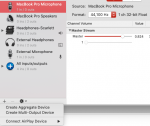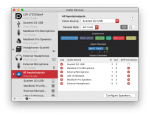You are using an out of date browser. It may not display this or other websites correctly.
You should upgrade or use an alternative browser.
You should upgrade or use an alternative browser.
Talkback mic
- Thread starter Dickerson
- Start date
guitarplayr82
New member
Plug a mic into one of your interface channels, set up a track in GarageBand with that mic set as the input (make sure monitoring is turned on on the track), and whenever you need to use the talkback mic, just arm the talkback track for recording and you're good to go!
You could also use a dedicated console such as the PreSonus Monitor Station if you wanted to make the job a little bit easier.
You could also use a dedicated console such as the PreSonus Monitor Station if you wanted to make the job a little bit easier.
Richard Monroe
Well-known member
The other simple solution is to just get a headphone amp, for starters. The headphone or line out on the interface goes to the main inputs on the headphone amp, and then to however many sets of cans you need. Then, the talkback mic goes to any preamp at all, and then from a line out on the preamp to the aux in on the headphone amp. I find it useful to use a dynamic with a switch, so you can easily just turn off the talkback mic input without adjusting gain levels to avoid bleed if you don't have a control room, and feedback if you do.
Of course, we cringe at the concept of buying a mic preamp just for a talkback mic, but most of us have one lying around that we haven't even thought of. Remember- you're not recording it, so it doesn't have to be a good one. Any old mixer, SIAB, portable recorder, PA head, acoustic guitar amp, old cassette recorder, etc., pretty much anything that has a mic input and a line out will do. I often use my Zoom H4n handheld recorder for this. I plug the mic into the Zoom, and take a line from the headphone output to the aux in on the headphone amp.
That way, you don't use up one of your precious recording channels just for a talkback mic, and the signal never goes anywhere near the recorder. Once your levels are set, just use the switch on the mic to turn talkback on and off. The cool part is- you're not recording it, so it doesn't have to sound good. It's one application where you can use dirt cheap mics and dirt cheap preamps. A used cheap Behringer mixer will work fine for this. Spook around for any used gear with a mic in and a line out, or use something you have lying around that you might not even consider as recording gear.
Here's a badass talkback preamp:
Behringer XENYX 502 | 8thstreet.com | Call 1-800-878-8882 | Free Shipping on most orders!
Here's your badass mic with a switch-
Nady StarPower SP-1 Microphone: Shop Pro Audio & Other Musical Instruments | Musician's Friend
Just make sure that whatever headphone amp you use has at least 2 main inputs. You can use one L/R pair or stereo in for the main mix and one for talkback. If you also have aux ins on the individual channels, that's nice, as later you can learn to build custom headphone mixes. For right now, you just need to get it out there.-Richie
Of course, we cringe at the concept of buying a mic preamp just for a talkback mic, but most of us have one lying around that we haven't even thought of. Remember- you're not recording it, so it doesn't have to be a good one. Any old mixer, SIAB, portable recorder, PA head, acoustic guitar amp, old cassette recorder, etc., pretty much anything that has a mic input and a line out will do. I often use my Zoom H4n handheld recorder for this. I plug the mic into the Zoom, and take a line from the headphone output to the aux in on the headphone amp.
That way, you don't use up one of your precious recording channels just for a talkback mic, and the signal never goes anywhere near the recorder. Once your levels are set, just use the switch on the mic to turn talkback on and off. The cool part is- you're not recording it, so it doesn't have to sound good. It's one application where you can use dirt cheap mics and dirt cheap preamps. A used cheap Behringer mixer will work fine for this. Spook around for any used gear with a mic in and a line out, or use something you have lying around that you might not even consider as recording gear.
Here's a badass talkback preamp:
Behringer XENYX 502 | 8thstreet.com | Call 1-800-878-8882 | Free Shipping on most orders!
Here's your badass mic with a switch-
Nady StarPower SP-1 Microphone: Shop Pro Audio & Other Musical Instruments | Musician's Friend
Just make sure that whatever headphone amp you use has at least 2 main inputs. You can use one L/R pair or stereo in for the main mix and one for talkback. If you also have aux ins on the individual channels, that's nice, as later you can learn to build custom headphone mixes. For right now, you just need to get it out there.-Richie
miroslav
Cosmic Cowboy
I never use the talkback mic...I just make hand gestures. 

Another added way to enhance your talkback setup for a band/group session is to put any old mic set to omni, out in the middle of the room where it will equally pick up everyone, and use THAT mic for feeding the talkback from the musicians as some may not be near a mic, or the mics used for tracking are way to loud/soft and not level-balanced for talkback since they are focusing on recording duties,


Another added way to enhance your talkback setup for a band/group session is to put any old mic set to omni, out in the middle of the room where it will equally pick up everyone, and use THAT mic for feeding the talkback from the musicians as some may not be near a mic, or the mics used for tracking are way to loud/soft and not level-balanced for talkback since they are focusing on recording duties,
Better solution to a very old problem!
This is a very old thread, but if you google "Talkback mic in GarageBand", this is the first hit, so an updated answer may help people like me.
Since this answer was written, Mac OS has received two incredibly useful features in Audio Midi Setup, called "Aggregate Device" and "Multi-Output Device"

For this answer, we will need an Aggregate Device. This allows you to take all of your audio devices (USB interfaces, Firewire interfaces, built-in devices, both the headphones in/out, as well as onboard mic and speakers) and put them into a single virtual audio interface.

The great advantage of this is that, in GarageBand, you no longer have to pick just one of the interfaces for your inputs. Now you can pick this aggregate, virtual device, and all of your inputs are going to be available on every track.
So, for talkback mic, you don't have to sacrifice any of your interface inputs. Just pick your built-in mic on your Mac(Book), and assign it to your talkback track (as per the original advice above).
The other feature, Multi-Output Device is great for monitoring while recording someone else. You create a new Multi-Output Device, then assign every interface you have for simultaneous audio output. Choose the new multi-output as your output interface in the GarageBand and you're good. That way, whatever is coming out of your GarageBand will be sent to all of your outputs simultaneously.
Now, you plug in your own headphones into your Mac headphone output, you give the other set to the person you're recording, plug them into the interface (for direct monitoring),. They set their own monitoring volume on the interface, you set yours on the Mac. No need for a multi-headphone amp.
Plug a mic into one of your interface channels, set up a track in GarageBand with that mic set as the input (make sure monitoring is turned on on the track), and whenever you need to use the talkback mic, just arm the talkback track for recording and you're good to go!
This is a very old thread, but if you google "Talkback mic in GarageBand", this is the first hit, so an updated answer may help people like me.
Since this answer was written, Mac OS has received two incredibly useful features in Audio Midi Setup, called "Aggregate Device" and "Multi-Output Device"

For this answer, we will need an Aggregate Device. This allows you to take all of your audio devices (USB interfaces, Firewire interfaces, built-in devices, both the headphones in/out, as well as onboard mic and speakers) and put them into a single virtual audio interface.

The great advantage of this is that, in GarageBand, you no longer have to pick just one of the interfaces for your inputs. Now you can pick this aggregate, virtual device, and all of your inputs are going to be available on every track.
So, for talkback mic, you don't have to sacrifice any of your interface inputs. Just pick your built-in mic on your Mac(Book), and assign it to your talkback track (as per the original advice above).
The other feature, Multi-Output Device is great for monitoring while recording someone else. You create a new Multi-Output Device, then assign every interface you have for simultaneous audio output. Choose the new multi-output as your output interface in the GarageBand and you're good. That way, whatever is coming out of your GarageBand will be sent to all of your outputs simultaneously.
Now, you plug in your own headphones into your Mac headphone output, you give the other set to the person you're recording, plug them into the interface (for direct monitoring),. They set their own monitoring volume on the interface, you set yours on the Mac. No need for a multi-headphone amp.
